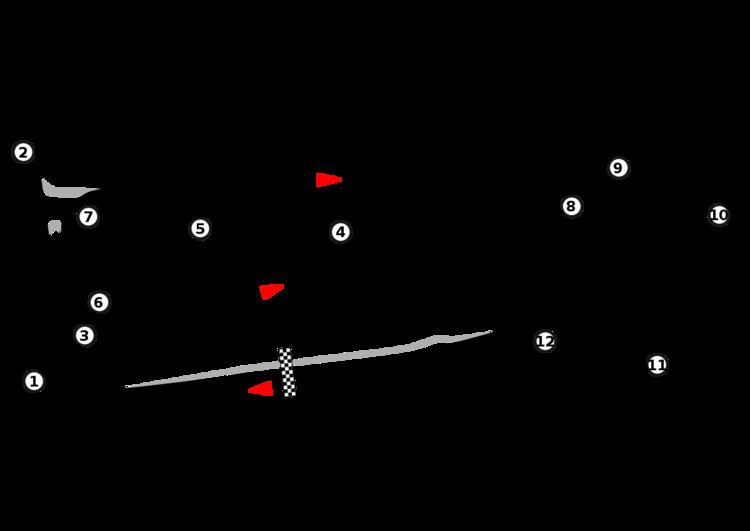Time zone GMT Turns 13 | Length 2.969 mi (4.779 km) Length 2.00 mi (3.22 km) Phone +44 1953 887303 | |
 | ||
Similar Oulton Park, Brands Hatch, Donington Park, Cadwell Park, Silverstone Circuit Profiles | ||
Having a blast at snetterton circuit norfolk 29 6 15
Snetterton Circuit is a motor racing course in Norfolk, England, originally opened in 1953. Owned by MotorSport Vision, it is situated on the A11 road 12 miles (19 km) north-east of the town of Thetford and 19 miles (31 km) south-west of the city of Norwich. The circuit is named after the nearby village of Snetterton to the north-west of the circuit, although much of the circuit lies in the adjoining civil parish of Quidenham.
Contents
- Having a blast at snetterton circuit norfolk 29 6 15
- Snetterton circuit classic mini b18 type r vtec
- Pre racing history
- Racing history
- Circuit developments
- Snetterton 300 Circuit
- Snetterton 200
- Snetterton 100
- Cars
- Motorcycles
- References
The circuit hosts races from series including the British Touring Car Championship, British Formula Three Championship and British Superbike Championship. From 1980 to 1994, the track hosted the UK's first 24-hour race, the Willhire 24 Hour. From 2003 to 2013 the Citroen 2CV 24 Hour Race was held at Snetterton on the 200 Circuit.
Snetterton circuit classic mini b18 type r vtec
Pre-racing history
Snetterton was originally an RAF airfield, RAF Snetterton Heath, later used by the United States Army Air Force. The airfield opened in May 1943 and closed in November 1948.
Racing history
After its use as a USAF base, Snetterton was first used for motorcycle racing in 1953, organised by the Snetterton Combine, an association of clubs in Norfolk and Suffolk.
The track was used by both Team Lotus (Formula One) and Norfolk Racing Co (Le Mans) to test their racing cars. In the 1960s and early 1970s the circuit was 2.7 miles in length. Sear corner was 80 m further from Riches corner and led onto the "Norwich Straight" clearly visible in satellite maps and currently used by a Sunday market. The straight ended in a hairpin bend leading to Home Straight which joined the existing track at the Esses but is now a main access road for the circuit. Russell bend was added in the 1960s and named after Jim Russell who ran a racing drivers school at the circuit. Initially added to improve safety by slowing vehicles as they approached the pits, Russell bend was the scene of many accidents and was later altered to its present configuration.
Circuit developments
In October 2005, Jonathan Palmer of MotorSport Vision, the owners of Snetterton Circuit, announced that the circuit would undergo extensive rebuilding work, in order to lengthen the circuit and improve its facilities.
On 23 September 2010, MSV announced that construction of the new infield section and track improvements would be finished in time for the 2011 motorsport season. The main development was the addition of a new one mile infield section, after Sear Corner, which was replaced and renamed Montreal, in deference to it being modelled on the Circuit Gilles Villeneuve hairpin. The final chicane before Senna Straight was also removed and replaced by an extension to Coram curve coupled with a new, tight, left-hand corner named Murrays. In addition to the track work, the redevelopment also improved spectator viewing and increased safety.
Snetterton 300 Circuit
The 300 Circuit is 2.97 miles (4.78 kilometres) long, Snetterton's longest layout and the second longest racing track in the country. The track incorporates much of the previous circuit with the infield section that was completed in 2011. The 300 track has been designed to bring international levels of racing to the circuit by gaining an FIA Grade 2 Licence. The layout also hosts major British motorsport championships. The British Formula 3 Championship and British GT Championship were the first of these to visit the new layout on 14 and 15 May 2011. The British Touring Car Championship with its ToCA support package also uses this layout, as does the British Superbike Championship. In 2016, ahead of Justin Wilson's 38th birthday, the Montreal hairpin was renamed Wilson, in memory of the Yorkshire IndyCar driver killed at the 2015 Pocono 500.
Snetterton 200
This layout is closest to the pre-2011 layout. The main differences between the original layout and the 200 layout are the re-profiled turns 2 and 13, which have been designed to provide better opportunities for overtaking. This layout is mainly used for club and local racing.
Snetterton 100
The 100 layout is made up solely of the new 1 mile infield section and is mainly used for testing and as a race school. Both the 100 layout and the 200 layout can be used simultaneously.
The first event which both events were used simultaneously was the BRSCC meeting held on the 29 and 30 May 2011. There was club racing on the outer circuit (VW Fun Cup, Saker Challenge, TVRs and Mighty Minis) and two rounds of the British Sprint Championship on the inner circuit.
Cars
The current 300 circuit lap record was set by Felipe Nasr from Brazil driving a Carlin prepared Dallara F308-Volkswagen in the 2nd race of the 2011 British GT / F3 meeting. The lap was 1m 39.933s at an average speed of 106.95 mph.
Prior to the introduction of the 300 circuit in 2011, the lap record stood at 56.095 (125.27 mph) set by Klaas Zwart, during a BRSCC meeting in August 2007. During qualifying he set an unofficial lap record of 54.687 (128.50 mph).
Motorcycles
The 300 official solo motorcycle lap record is currently 1:47.714, a speed of 99.22 mph (159.68 km/h), set by Shane Byrne on a PBM Ducati Panigale during a British Superbike Championship race in July, 2016, beating the previous time of 1:47.881, set by Josh Brookes during a BSB race in June, 2014.
